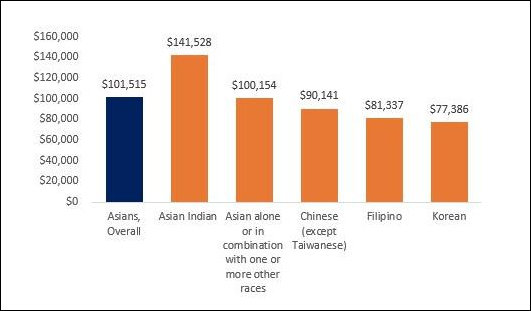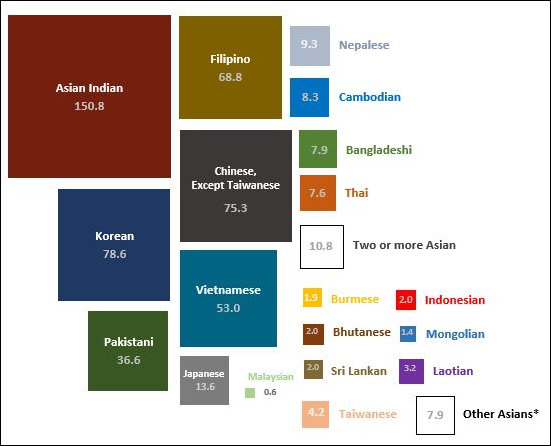In their obsession with identity politics and racial/ethnic classification, federal and state governments in the United States classify millions of Americans as “Asian.” From a sociological perspective, “Asian” is a meaningless term. Asia is the world’s largest continent and has more diverse indigenous populations than any other. As this graphic from the University of Virginia’s Statchat blog makes clear, Virginians classified as “Asian” include people who trace their ancestry to the Indian subcontinent, Korea, China, the Philippines, Vietnam, Cambodia, Japan, Thailand, Pakistan, and many other countries. These people do not share a common language, culture, or history.
The circumstances under which these groups came to the United States vary widely. Many Indians and Pakistanis come from wealthier strata of their home countries and attended universities here. Others, like the Vietnamese and Cambodians, fled the Communists and landed penniless on American shores. Many Filipinos came to the U.S. by means of association with the U.S. Navy. One should be cautious when generalizing about “Asians.”
“Asians in Virginia are often stereotyped as a successful minority due to their high median household income and their significant share of employment in STEM-related occupations,” write the StatChat author, Kyaw Khine. Not surprisingly, he has found considerable variability among Asian groups in education and income.

Median household incomes of selected Asian population by country of origin, Virginia, 2017. Source: StatChat blog.
By far, Virginians of Indian origin outperform other “Asian” groups — exceeding all other groups in the percentage holding a B.A. degree, and earning 50% more than Chinese, Filipinos or Koreans. The Tiger Mom stereotype applies to ethnic Chinese, but here in Virginia, Indians are the high achievers. Khine attributes the differential in part to the fact that Virginia, especially Northern Virginia, has attracted educated workers through the H1B visa program. Since 2001, half of all H1B visas have been awarded to Indian nationals.
In summary, writes Khine:
The foreign-born Asian population in Virginia is diverse and consists of permanent residents, temporary workers, and humanitarian migrants. While certain Asian groups have higher shares of their populations holding high-level academic degrees, other Asian groups–especially those fleeing their home countries because of violence and persecution–have higher proportions holding less than a high-school diploma. Among the latter groups, median household incomes are generally much lower.
Bacon’s bottom line: Khine’s point is well taken. On this blog I have made much of the fact that “Asians” outperform whites, blacks and Hispanics in educational achievement, particularly in Standards of Learning test scores. I have attributed their superior performance to differences in culture — more tightly knit families, more self-discipline, greater willingness to defer gratification — never acknowledging that “Asians” encompass people from a wide variety of backgrounds. That said, “Asians” out-perform other ethnicities even when adjusted for economically advantaged or disadvantaged status. Regardless of their country or origin, poor “Asians” do better academically than poor whites, blacks and Hispanics.
Of course, if I am guilty of generalizing about “Asians,” I follow the lead of government officials and educators who exhibit a mania for racial classification. Racial classifications permeate the collection of statistics and every level of public-policy analysis. I look forward to the day when we can cease classifying one another by race and begin treating one another as individuals.



